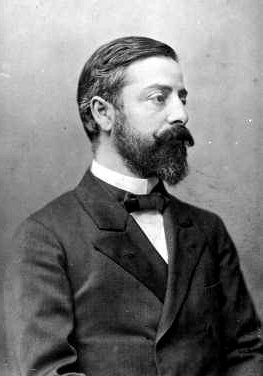Emil Zuckerkandl
Emil Zuckerkandl (September 1, 1849 – May 28, 1910) was an Austrian anatomist who made significant contributions to the field of anatomy, particularly in the study of the human body's comparative anatomy and embryology. He is best known for his work on the anatomy of the pelvis, the blood vessels, and the endocrine glands, as well as for the Zuckerkandl's organ, a small body of chromaffin cells associated with the sympathetic nervous system.
Biography[edit | edit source]
Emil Zuckerkandl was born in Győr, Hungary (then part of the Austrian Empire) in 1849. He pursued his medical studies at the University of Vienna, where he was influenced by prominent figures in the field of anatomy and pathology. After completing his studies, Zuckerkandl spent his career in Vienna, becoming a key figure in the medical community there.
Throughout his career, Zuckerkandl was dedicated to teaching and research. He held several academic positions, including professorships at the University of Vienna, where he educated many students in the intricacies of human anatomy. His contributions to anatomical literature, particularly his studies on the comparative anatomy of the pelvis and the vascular and nervous systems, have left a lasting impact on the field.
Contributions to Anatomy[edit | edit source]
Zuckerkandl's work in anatomy was extensive and covered various aspects of the human body. Some of his most notable contributions include:
Zuckerkandl's Organ[edit | edit source]
Perhaps the most well-known of his contributions is the identification of Zuckerkandl's organ, a collection of chromaffin cells found near the adrenal glands. These cells are part of the sympathetic nervous system and play a role in the body's response to stress.
Pelvic Anatomy[edit | edit source]
Zuckerkandl conducted detailed studies of the pelvic region, contributing to a better understanding of its anatomy and its significance in various medical conditions. His work in this area has been influential in both anatomy and gynecology.
Vascular System[edit | edit source]
He also made significant contributions to the study of the vascular system, including the anatomy of the blood vessels and their role in health and disease. His research has been fundamental in the development of vascular surgery and related fields.
Legacy[edit | edit source]
Emil Zuckerkandl's legacy in the field of anatomy is marked by his meticulous studies and the breadth of his contributions. His work continues to be referenced by anatomists, surgeons, and researchers in related fields. The Zuckerkandl's organ remains a topic of interest in both anatomy and pathology, illustrating the lasting impact of his research.
Zuckerkandl passed away in Vienna in 1910, but his influence on the study of human anatomy endures. He is remembered as a dedicated educator and a pioneering anatomist whose work has shaped the understanding of the human body.
Search WikiMD
Ad.Tired of being Overweight? Try W8MD's physician weight loss program.
Semaglutide (Ozempic / Wegovy and Tirzepatide (Mounjaro / Zepbound) available.
Advertise on WikiMD
|
WikiMD's Wellness Encyclopedia |
| Let Food Be Thy Medicine Medicine Thy Food - Hippocrates |
Translate this page: - East Asian
中文,
日本,
한국어,
South Asian
हिन्दी,
தமிழ்,
తెలుగు,
Urdu,
ಕನ್ನಡ,
Southeast Asian
Indonesian,
Vietnamese,
Thai,
မြန်မာဘာသာ,
বাংলা
European
español,
Deutsch,
français,
Greek,
português do Brasil,
polski,
română,
русский,
Nederlands,
norsk,
svenska,
suomi,
Italian
Middle Eastern & African
عربى,
Turkish,
Persian,
Hebrew,
Afrikaans,
isiZulu,
Kiswahili,
Other
Bulgarian,
Hungarian,
Czech,
Swedish,
മലയാളം,
मराठी,
ਪੰਜਾਬੀ,
ગુજરાતી,
Portuguese,
Ukrainian
Medical Disclaimer: WikiMD is not a substitute for professional medical advice. The information on WikiMD is provided as an information resource only, may be incorrect, outdated or misleading, and is not to be used or relied on for any diagnostic or treatment purposes. Please consult your health care provider before making any healthcare decisions or for guidance about a specific medical condition. WikiMD expressly disclaims responsibility, and shall have no liability, for any damages, loss, injury, or liability whatsoever suffered as a result of your reliance on the information contained in this site. By visiting this site you agree to the foregoing terms and conditions, which may from time to time be changed or supplemented by WikiMD. If you do not agree to the foregoing terms and conditions, you should not enter or use this site. See full disclaimer.
Credits:Most images are courtesy of Wikimedia commons, and templates, categories Wikipedia, licensed under CC BY SA or similar.
Contributors: Prab R. Tumpati, MD

